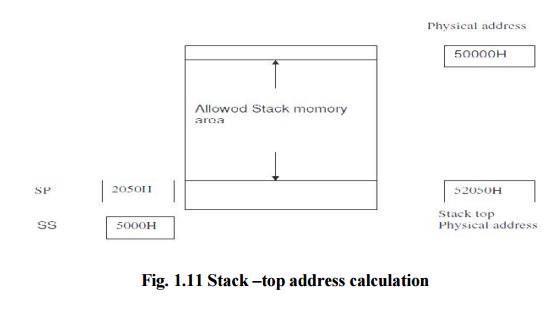Chapter: Microprocessor and Microcontroller : 8086 Microprocessor
memory Stacks in 8086 Microprocessor
Stacks
The stack
is a block of memory that may be used for temporarily storing the contents of
the registers inside the CPU. It is a top-down data structure whose elements
are accessed using the stack pointer (SP) which gets decremented by two as we
store a data word into the stack and gets incremented by two as we retrieve a
data word from the stack back to the CPU register.
The
process of storing the data in the stack is called ‘pushing into’ the stack and
the
reverse
process of transferring the data back from the stack to the CPU register is
known as
‘popping
off’ the stack. The stack is essentially Last-In-First-Out
(LIFO) data segment. This
means that
the data which is pushed into the stack last will be on top of stack and will
be popped off the stack first.
The stack
pointer is a 16-bit register that contains the offset address of the memory
location in the stack segment. The stack segment, like any other segment, may
have a memory block of a maximum of 64 Kbytes locations, and thus may overlap
with any other segments. Stack Segment register (SS) contains the base address
of the stack segment in the memory.
The Stack
Segment register (SS) and Stack pointer register (SP) together address the
stack-top as explained below:

If the
stack top points to a memory location 52050H, it means that the location 52050H
is already occupied with the previously pushed data. The next 16 bit push
operation will decrement the stack pointer by two, so that it will point to the
new stack-top 5204EH and the decremented contents of SP will be 204EH. This
location will now be occupied by the recently pushed data.
Thus for
a selected value of SS, the maximum value of SP=FFFFH and the segment can have
maximum of 64K locations. If the SP starts with an initial value of FFFFH, it
will be decremented by two whenever a 16-bit data is pushed onto the stack.
After successive push operations, when the stack pointer contains 0000H, any
attempt to further push the data to the stack will result in stack overflow.
After a
procedure is called using the CALL instruction, the IP is incremented to the
next instruction. Then the contents of IP, CS and flag register are pushed
automatically to the stack. The control is then transferred to the specified
address in the CALL instruction i.e. starting address of the procedure. Then
the procedure is executed.

Related Topics